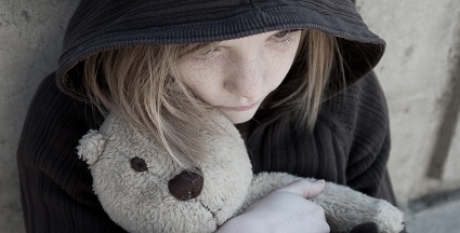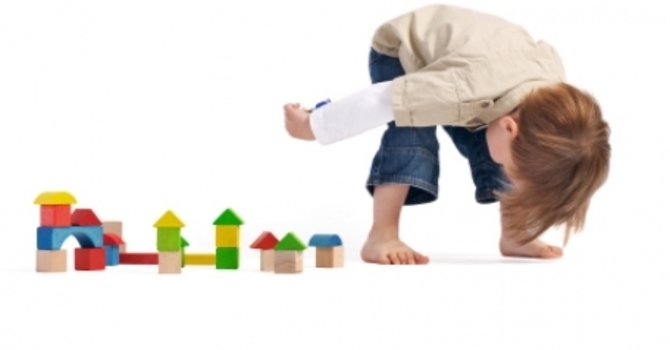
The Effects of Childhood Trauma
The word "trauma" is one of those heavily overused words in our culture, to the extent that it has become almost meaningless. A tumble in the markets, a stressful visit with relatives, a low grade on an exam, and a scraped knee from falling off a bike might be described as "traumatic." But some events in a child's life can be literally traumatizing, in the sense that they carry long-lasting and profoundly debilitating consequences for the child.
Trauma undermines the world's order, control, and predictability.
In order for the average child to feel she can act confidently and take the risks necessary for development, she requires the world to be a predictable, understandable, safe place. Sometimes, however, though we may do our best to protect them, life can pose painful and frightening situations to children, such as being involved in a fatal vehicle collision, losing a friend or parent to death, witnessing (or experiencing) domestic violence, losing a house and possessions to fire, watching parents consume and fall under the influence of drugs and alcohol, experiencing serious illness, being victimized by physical or sexual abuse, or experiencing a natural disaster. Events such as these can leave children confused, frightened, and wary. The world is suddenly no longer a trustworthy, predictable, safe place. The ground, which was once so sturdy and consistent, drops out from beneath their feet. The psychological effects can be deep-seeded and long-lasting.
When an experience or event overwhelms a child's natural abilities to understand, cope, and adjust, we call it a traumatic experience. And if a child has truly been traumatized, it's important to get help, and take steps to prevent long-term difficulties. Therefore, adults must learn to gauge which events are traumatic. To complicate matters, however, an event which may be traumatic for one child might be a harmless challenge for another. So what events are truly traumatic? How do we know if a child has been traumatized? And, perhaps most importantly, how do we help to restore a child's health and well-being when they are suffering from the effects of trauma?
First, it should be noted that it is the response of the individual child that determines whether an event has been traumatizing. One child may react with healthy grief to the death of a grandparent, while another might slip into post-traumatic stress response. It is important to gauge a given child's reaction to a situation before presuming he or she has traumatized.
So how do we know if a child has been traumatized?
Most researchers tell us that the crux in understanding trauma and its resolution is the child's experience of a debilitating loss of control. When a child is faced with a traumatic experience, she perceives that the predictability and order of the world has gone askew. She is then unable to regulate and modulate her neurological and physiological arousal. This then causes a rupture in the child's capacity to process, integrate, and categorize what's happening to her, inside her, around her. There is a breakdown in the child's capacity to regulate his or her internal states. If the child's level of distress remains elevated, she can not make associations with the relevant thoughts, emotions, and sensory experiences that are bombarding her. Instead, these can become dissociated into sensory fragments, so that she is left in a daze, wondering what's happening, unable to comprehend or come up with any appropriate plan of action.
There are two fundamental behavioural responses to this state: hypo-reactivity (the child becomes under-responsive, emotionally numbed, and dazed), and hyper-reactivity (the child becomes on-edge, overly vigilant for danger, wary, and easily-startled). With hypo-reactivity, it could be said that a part of the child's brain is in a befuddled stupor, similar to how an adult might feel in the throes of a disorienting bout of the flu. The child feels groundless, confused, and empty. She cushions herself in a cloud of numbness and non-feeling, similar to a state of medical shock. On the other hand, with hyper-reactivity, she goes into full-alarm mode, feeling flustered, disorganized, out-of-control, too easily startled, and scared to trust her environment. It's as though there are hungry tigers in the trees around her, and she's poised to flee or freeze-up at the first rustle in the leaves, or the first crack of a branch.
The child's natural propensity for healing
Now, just as not all potentially traumatic experiences will necessarily traumatize a given child, we should remember that not all children require intervention in order to recover. In many cases, a healthy and adaptive healing process kicks in, as so often happens with the incredible human body. If the child's experience is not too overwhelming, she will follow her natural drive to master what is painful or confusing (traumatized children desperately want to restore a sense of control). In a healthy, adaptive response, this drive will supersede the opposing natural drive to avoid painful emotions. With work and over time, the child will move toward a healthy course of healing, with the following results: she will begin to perceive the event correctly; recall the event when she wants to; translate her various perceptions into a clear meaning & narrative, and then relate this meaning to an enduring attitude; express her emotions as well as her actions; decide on appropriate courses of action; select and revise her memories, attitudes, and belief systems to fit a new developmental line made necessary by experience; and, finally, think about or talk about the experience without becoming overwhelmed by what she feels.
If all goes well, a child will likely go through three phases of recovery, as follows:
1. Impact (shock, numbness, helplessness which can be brief but debilitating). The child feels predominantly physiological symptoms include tightness in the throat, choking & shortness of breath, an empty feeling in the abdomen, lack of muscle power, sleep disturbance, appetite disturbance, and often feelings of shame and guilt.
2. Recoil (the child attempts to deal emotionally with event).
The child obsesses about the event (compensatory fantasies & planning, phobic reactions), and engages in blaming, of both self and others such as parents, or the police. This is often then countered by periods of avoidance.
3. Reorganization (return to psychological equilibrium).
The child is able to gather all of the sensory stimuli associated with the event and organize it into a coherent, understandable narrative. Emotions around the event settle, and the child can discuss or think about it without becoming overwhelmed. Ongoing safety and healthy experiences begin to convince the child the world is safe and predictable again.
What to watch out for:
If a child has been traumatized beyond their capacity to recover, one of the primary signs we will see is a heightened responsiveness to trauma-specific stimulus. Any reminders of the event can trigger increased levels of chemicals that in turn trigger autonomic nervous system arousal (increased levels of catecholamines, specifically epinephrine and norepinephrine, which set in motion a physiological alarm system, sometimes referred to as the fight-or-flight response; along with decreased levels of corticosteroids and serotonin, resulting in an inability to moderate the fight-or-flight response; as well as increased levels of endogenous opioids, resulting in pain analgesia, emotional blunting, and memory impairment). This can put the child in a constant state of readiness for emergency response.
However, in many cases, the child will also have a heightened responsiveness to intense, non-trauma-specific stimuli. For example, they will demonstrate a pronounced startle reaction to loud noises or other abrupt experiences. This is a state of hyperarousal, in which the child is extremely vigilant, keeping an ever-wary attitude toward all circumstances. Not only is this exhausting, but it can be desperately cyclical, in that the child's physiological response to the stimulus actually serves to reinforce the hypervigilance (i.e., the banging sound of the hammer at the construction site next door set my heart racing, and now my body is stiff and scared and ready to run, so, therefore, I must be in danger, so I've got to keep my eyes and ears peeled for danger, which will in turn help me to notice the first unusual sound or sight I hear or see). For the sympathetic nervous system to be so consistently on alert is exhausting for the child, and exhausting for the brain, and can cause long term physiological damage.
Specific symptoms of traumatization
Furthermore, we can watch for specific symptoms indicating that a child may be experiencing a maladaptive post-traumatic response. The following portion of this article is broken down into a general symptom list, followed by some more age-specific symptoms, and finally lists the qualifying symptoms to be diagnosed with post-traumatic stress disorder (PTSD) by the Diagnostic and Statistical Manual, 4th Edition, Text Revised (DSM-IV-TR)
General symptom list
Mind (Cognitive Reactions)
1.Confusion (an overall sense of mental disarray)
2.Problem-Solving Difficulties (especially generating alternative solutions),
3.Time Distortions (greater than expected for developmental stage); e.g., compressing, expanding, or resequencing periods of time
4.Problems in setting priorities
And, over time:
5.Confusion
6.Fear of going crazy
7.Preoccupation with the incident
8.Orientation toward the past
9.Denial of the event�s significance
10.In some cases following a traumatic death, perceiving ghosts (attributed to posttraumatic misperception or hallucination)
Body (Somatic Reactions)
1.Pounding heart
2.Nausea
3.Cramps
4.Sweating
5.Shock symptoms
6.Headaches
7.Muffled hearing
And, over time:
8.Fatigue
9.Increased susceptibility to and contraction of illness
Heart (Affective Reactions)
1.Irritability
2.Generalized fear
3.Startle reaction
4.Anxiety
5.Frustration
6.Anger (particularly explosive or maladaptive expressions thereof)
And, over time:
7.Fear of reoccurrence
8.Phobias
9.Oversensitivity
10.Depression
11.Grief
12.Guilt
13.Resentment
14.Worry about physical health
15.Doubts about the self, including comments about body confusion, self-worth, and desire for withdrawal.
16.Self-destructive behaviours
Hands (Behavioural Reactions)
1.Slowness
2.Aimless wandering
3.Dejection
4.Memory problems
5.Hysteria
6.Out-of-control behaviour
7.Hyperactivity
And, over time:
8.Sleep problems
9.Social withdrawal
10.Repetition, re-enactment, or flashbacks to trauma, often expressed through a need to talk compulsively about the event or, in the case of preverbal or young children, to play the trauma out repeatedly without resolution
11.Relationship or family problems
12.Flashbacks
13.Avoidance of incident location
14.Substance abuse
15.Ego constriction (infants may become despondent, hopeless, anxious, or withdrawn; 2- to 5-year-olds may become overcontrolling, impulsive, order-mongering, overly-structured, or helpless; 6- to 9-year-olds may begin feeling guilty, experience a loss of rootedness, an increased need for protectors, and a loss of purpose; 10- to 12-year-olds may feel a sense of futility, work paralysis, or incompetence; 13- to 18-year-olds may experience self-consciousness, lack of commitment, or a prolonged moratorium)
16.Developmental Regression (e.g., crawling into bed with ones parents, sucking ones thumbs, or wetting the bed at night, when these habits have already been outgrown)
B. Age-specific symptoms of traumatization
Some symptoms can be age-specific, in that younger traumatized children may react differently than older traumatized children. The following age-specific symptoms may signify a post-traumatic response that warrants intervention:
Post-Traumatic symptoms in pre-school age children:
1.Sleep disturbances (inability to fall asleep, nightmares, night terrors);
2.Regressive behaviours (thumb-sucking, bedwetting, sleeping with parents) or regression to previous levels of functioning;
3.Apathy and withdrawal (sense of distrust, not safe from further harm);
4.Subdued and muted behaviour (unusually quiet and seemingly detached from others), though generally children do not experience the psychic numbing that is typical of traumatized adults;
5.Some denial of facts or memories of the event * (this is not true for all traumatized young children). This can include avoidance of themes or issues related to the event, or ignoring certain people or conditions;
6.Reenactments and unsatisfying plans involving traumatic themes, or highly thematic play (fascination with certain themes or ritualistic interactions);
7.Anxious attachment behaviours (greater separation or stranger anxiety, clinging to previously cherished objects, whining, crying, clinging, tantrums);
8.Relatively brief grieving period (following death or traumatic loss); and,
9.Denial of permanence of change (following death or traumatic loss).
* It should be noted that most (but not all) children under 3.5 years tend to forget their experiences, due to repressions normal to the first few years of life, and due to nonverbal encoding of memories. Children over 3.5 years, however, generally do not become amnesiac or deny or repress memories, but remember them vividly.
Post-Traumatic symptoms in school age children:
1.Lowered intellectual functioning, performance declines in sports, hobbies;
2.Inner plans of action (attempts at denial, compensation, reversal, or retribution through fantasy);
3.Obsessive talking about event;
4.Isolation of affect (i.e., only expressing one emotion);
Discrepancy of mood (i.e., may exhibit feelings inappropriate to the situation);
5.Constant anxious arousal;
6.Behavioural alterations (i.e., a change in normal patterns of behaviour, which is often an intentional effort on behalf of the child to relieve anxiety, or to gain some needed attention, or to organize and understand new, unsettling information about the world and themselves);
7.Problems relating to peers;
8.More elaborate reenactments of the event; and,
9.Psychosomatic complaints (stomach-aches, headaches, digestive upset)
Post-Traumatic symptoms in Teens
1.Premature closure of identity formation;
2.Acting-out behaviour (abuse of drugs and/or alcohol, truancy, violence, sexual behaviour, running away);
3.Self-criticism and lowered self-esteem (their developmentally-appropriate sense of increasing power in world (and, let�s be honest, adolescent egocentrism) takes a mighty blow); but, paradoxically, many also often experience �
4.Intensification of self-centredness;
5.Fatalistic fear of repetition of the event in the future;
6.Suicidality;
7.Depressive behaviours;
8.Academic decline;
9.�Too-old, too-fast� syndrome (a seeming loss of innocence and suppression of childhood joy, as the teen takes on some of the more heavy responsibilities of life); and,
10.Displaced anger.
Diagnostic criteria for a psychiatric diagnosis of Post-Traumatic Stress Disorder (309.81 PTSD, as listed in the DSM-IV-TR)
A.Child was exposed to a traumatic event including both:
1.experience or witness of actual or threatened death or serious injury, or threat to physical integrity of self or others; and,
2.the child�s response involved intense fear, helplessness (in children, this may be expressed as disorganized or agitated behaviour)
B.The event is persistently re-experienced in one or more of the following ways:
1.recurrent, intrusive, distressing recollections of event (images, thoughts, or perceptions). In young children, repetitive play may occur in which themes or aspects of the trauma are expressed.
2.recurrent, distressing dreams of even (in children, frightening dreams without recognizable content.
3.acting or feeling as if the traumatic event were recurring (reliving the experience, illusions, hallucinations, dissociative flashback episodes, including those that occur on awakening or when intoxicated) (in young children, trauma-specific reenactment may occur.
4.intense distress at exposure to internal or external cues that symbolize or resemble an aspect of traumatic event
5.physiological reactivity at exposure to cues the resemble aspect of event.
C. Persistent avoidance of stimuli associated with trauma and numbing of general responsiveness (not present before trauma), as indicated by three or more of the following:
1.efforts to avoid thoughts, feelings, or conversations associated with trauma
2.efforts to avoid activities, places, or people that arouse recollections of trauma
3.inability to recall important aspect of trauma
4.markedly diminished interest or participation in significant activities
5.feeling of detachment or estrangement from others
6.restricted range of affect (e.g. unable to have loving feelings)
7.sense of a foreshortened future (e.g. does not expect to have a career, marriage, children, or normal lifespan)
D.Persistent symptoms of increased arousal (not present before trauma) as indicated by two or more of the following:
1.difficulty falling or staying asleep
2.irritability or outbursts of anger
3.difficulty concentrating
4.hypervigilance
5.exaggerated startle response
E.Duration of disturbance (B, C, and D) is more than one month
F.Disturbance causes clinically significant distress or impairment of social, occupational, or other important areas of functioning.
The diagnosis is further specified acute if symptom-duration is less than three months, chronic if symptom-duration is three months or more, or delayed onset if the onset of symptoms is at least 6 months after the stressor.





